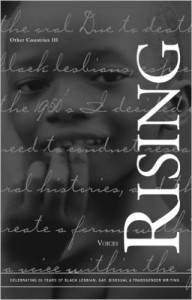 Voices Rising: Celebrating 20 Years of Black Lesbian, Gay, Bisexual & Transgender Writing
Voices Rising: Celebrating 20 Years of Black Lesbian, Gay, Bisexual & Transgender Writing
Edited by G. Winston James
Redbone Press. 583 pages, $25.
THE DEDICATION PAGE of Voices Rising bears a quotation from James Baldwin’s 1979 novel Just Above My Head. “Our history is each other. That is our only guide.” The book goes on to provide the raw material out of which such history is formed, including 101 short stories, poems, essays, interviews, and excerpts from novels and plays by 65 black gay men, lesbians, bisexuals, and transsexuals. Voices Rising is the third volume of black queer writing to be produced by Other Countries, a workshop established by Daniel Garrett in 1986 in New York to encourage literary expression in this community. The two previous volumes, Other Countries: Black Gay Voices (1988) and Sojourner: Black Gay Voices in the Age of AIDS (1993), created a space that’s revisited in Voices Rising, expanded this time to include the work of lesbians.
Baldwin’s benign presence hovers beatifically over the volume, a presence marked not only by the frequent mention of his name but also by the recurring themes of black adolescence, violence, music, and the church, which are four important components of his work. To these four themes is added the dark thread of AIDS to produce a rich weave of writing.
I counted at least nine contributions—Ernest Hardy’s “Blood, Prayer and Tears: 2002 A.D.” in particular sticks in the mind—that bear witness to the ravages of the disease and its human costs. In Craig Hickman’s “Guess Who Came to Dinner,” a concerned mother deals with the prospect of her adopted son getting AIDS from his boyfriend, but goes back into the past and narrates the travails of his orphaned childhood. Childhood and adolescence figure prominently in the volume as a site of identity formation. Seven powerful contributions, among them the masterful “Learning to Speak Heterosexual” by Robert R. Penn, operate in the revisited world of early youth. malik m.l.williams’ poem “He Remembers” ventures into the traumatic world of child sexual abuse by a father. In case of the extract from Bel Canto by Daniel Alexander Jones, queer individuation is routed through a young boy’s initiation into opera.
Popular culture in general and music in particular have long been acknowledged as instrumental in shaping queer identity. In “The D-train” Pamela Sneed writes, “music [is]a religious experience.” The quasi-religious adoration of singers is evident in the volume because it is generously star-dusted with names as chronologically diverse as Bessie Smith and Jill Scott. Marian Anderson, Billie Holiday, and Sylvester appear as fully-drawn characters in three contributions. Like music, dance also accomplishes the task of allowing queer youths to celebrate their sensuality. Sneed’s “The D-train” tells you to “celebrate/ newfound identity/ as we did in 1986-/ by dancing.” Eva Yaa Asantewaa, Gina Rhodes, Mistinguette, and Bil Wright rejoice in dance as a site of sexual identity performance.
Dangerous, furtive, irresistible homoeroticism courses through several pieces. “PATH” by G. Winston James and “In the Silent Bathroom #2” by Warren Adams II—to name just two—celebrate a sexual act that continues to flourish, in spite of socio-cultural and religious censure. At the same time, the church looms large over the black gay consciousness. “Gay men have been a critical part of the black church,” says a character in “sassy b. gonne” by Lisa C. Moore. The church is repeatedly evoked because of its vexed relationship with black gay men in particular. “West coast east” by Carlton Elliot Smith, “Come Mourning” by Christopher Adams, and Samiya Bashir’s “Jesus Gon’ Hear My Song, Sho’ Nuff” are a few notable examples. This collection should also be commended for its conscientious inclusion of transsexual voices in such powerful poems as “Question and Answer” by Alan E. Miller and “Cornbread Girl” by Imani Henry.
If I have any nits to pick, they are but few. Some conspicuous omissions from this volume are Barbara Smith, Bonnie Zimmerman, and Rita Mae Brown, whose pioneering work in raising black lesbian consciousness cannot be overestimated. Also, the book could have done with more meticulous proofreading. I found myself frequently deleting unwarranted punctuation marks and inserting them where they belonged. In one sentence “in flux” is incorrectly printed as one word, thereby confusing the sense of the sentence.
Other than that, G. Winston James and Other Countries deserve unstinting congratulations. All the contributions are informed by a keen awareness of the necessity for self-expression, which is an essential part of identity formation, which in turn gives rise to the need for a cultural, communal genealogy. One awaits the fourth volume with eagerness.
____________________________________________________________________
Niladri Chatterjee is a senior lecturer in the Department of English at the University of Kalyani, India.





